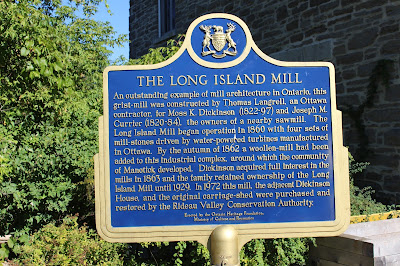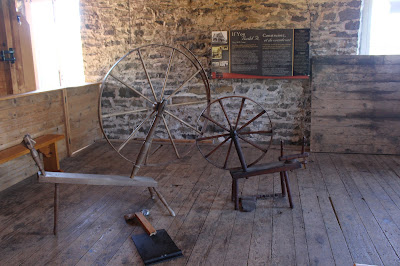A. Y. Jackson Park occupies the southwest corner of Bridge Street and Arthur Crescent, in Manotick, Ontario. Taking the path that meets Arthur Crescent at right angles leads to a place where the plaque commemorating A. Y. Jackson stands.
This park is dedicated to the memory of A. Y. (Alexander Young) Jackson, a leading member of the Group of Seven who lived and painted in Manotick from 1955 to 1962. Jackson was 72 and an internationally recognized landscape artist when he moved from Toronto to be with members of his family. From Manotick he continued to venture forth to sketch and paint landscapes.
Jackson was born in Montreal in October 1882. Despite leaving school at 12 to help support his family, he managed to study art in Chicago and Paris. Back in Quebec, he struggled as a painter and was tempted to move to the U.S. Fate intervened when Toronto artist Lawren Harris bought his painting The Edge of Maple Wood. In 1913, Harris and other artists invited Jackson to join them in Toronto.
Jackson enlisted in the army in World War I and was wounded in action in 1916. In 1917, still overseas, he became an official war artist. Returning to Toronto after the war, he helped form the Group of Seven in 1920.
Jackson was a key figure in the Group's legendary painting expeditions to Georgian Bay, Algoma and Lake Superior's north shore — much of it rugged wilderness accessible only by canoe. In 1927, he was the first Group member to paint the Arctic. The Group sought to capture the spirit of Canada on canvas as a way of expressing Canadian identity.
In 1962, Jackson moved from Manotick to Ottawa. After suffering a stroke in 1968 he went to live in Kleinburg near Toronto, and died there April 5, 1974. He is buried on the grounds of the McMichael Canadian Art Collection, alongside fellow Group of Seven artists Lawren Harris, Arthur Lismer, Frederick Varley, Franz Johnston and A. J. Casson.
Ce parc est dédié à la mémoire de A. Y. (Alexander Young) Jackson, un des chefs de file du Groupe des Sept, qui a vécu et pient à Manotick de 1955 à 1962. Jackson était un paysagiste de renommée internationale lorsqu'il a quitté Toronto à l'âge de 72 ans et s'est intallé ici pour dessiner et peindre des paysages.
Jackson est né à Montréal en octobre 1882. Bien qu'il ait quitté l'école à lâge de 12 ans pour subvenir aux besoins de sa famille, il est parvenu à étudier l'art à Chicago et à Paris. De retour au Québec, il épouvait des difficultés à subsister comme peitnre et a été tenté de s'établir aux États-Unis. Le destin a voulu que Lawren Harris, artiste de Toronto, achète sa peinture La lisière de l'érablière. En 1913, Harris et d'autres artisted ont invité Jackson à se joindre à eux à Toronto.
Jackson s'est enrôlé durant la Première Guerre mondiale et en 1916, il a été blessé au combat. En 1917, pendant qu'il se trouvait toujours outre-mer, il est devenu peintre de guerre attitré. De retour à Toronto à l'issue de la guerre, il a aidé à constituer le Group des Sept, qui a vu le jour en 1920.
Le Groupe s'est efforcé de fixer sur toile l'esprit du Canada dans le but d'exprime l'identité canadienne. Jacson a joué un rôle de premier plan dans les expéditions légendaires du Groupe dans la Baie georgienne, à Algoma et sur la Rive nord du lac Supérieur — des régions essentiellement sauvages accessibles uniquement en canoë. En 1927, il a été la premier membre du Groupe à partir peindre dans l'Arctique.
En 1962, Jackson a quitté Manotick pour Ottawa. En 1968, après avoir été victime d'un accident cérébrovasculaire, il s'est installé à Kleinbug, près de Toronto, et il y est mort le 5 avril 1974. Il ext enterré sur la propriété de la McMichael Canadian Art Collection, aux côtés d'autres membres du Groupe des Sept, en l'occurrence Lawren Harris, Arthur Lismer, Frederick Varley, Franz Johnston et A. J. Casson.
































































